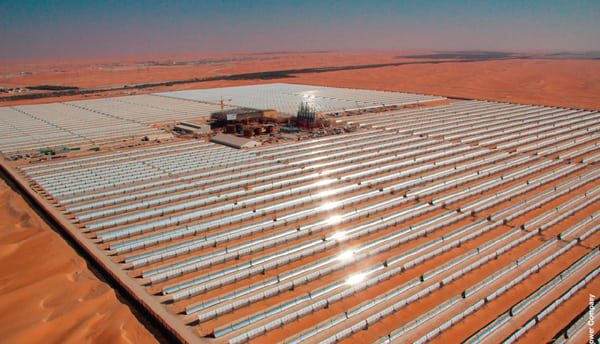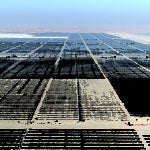Solar thermal technologies are experiencing increased popularity around the world. Three recent deployments illustrate how the technology and plant size specifics are tuned to local needs.
The United Arab Emirates (UAE) this March saw the inauguration of the 100-MW Shams 1 concentrated solar power (CSP) plant, a $600 million project that took three years to build in the western emirate of Abu Dhabi, at the heart of the country’s hydrocarbon industry. Spanning a square mile, the project is currently the world’s largest CSP plant, in terms of both power capacity and size. It features more than 58,000 mirrors mounted on 768 tracking parabolic trough collectors.
By concentrating heat from direct sunlight onto oil-filled pipes, Shams 1 (Figure 4) produces steam, which drives a turbine, and generates electricity. The solar project reportedly uses a natural gas–fired superheater to boost steam temperatures (from 380C to 540C) before it enters the turbine to dramatically increase the cycle’s efficiency. It also includes a dry-cooling system that significantly reduces water consumption—“a critical advantage in the arid desert of western Abu Dhabi,” said its developer, which is a joint venture comprising UAE renewables firm Masdar, France’s Total, and Spain’s Abengoa Solar. At least 66 national companies reportedly contributed with direct contracts to different phases of the project.
 |
| 4. A desert giant. The 100-MW Shams 1 concentrating solar power project in Madinat Zayed, in western Abu Dhabi, was officially opened this March. One of the world’s largest parabolic trough projects in terms of power capacity and size, the plant uses dry cooling to reduce water consumption. Courtesy: Abengoa Solar |
The UAE is seeking to vastly increase its power supplies to fuel a rapidly growing economy and expected population surge (the population shot up from 2.4 million in 1995 to 7 million in 2011). The country also suffers an extreme climate, with summer temperatures well over 50C, and water scarcity, which means all drinking water must be desalinated. The Abu Dhabi and Dubai emirate governments have backed renewables as a means to reduce dependence on their fossil fuel revenues. Another reason is that domestic consumption of produced units of oil and gas, which fetch stellar prices when exported, represent a substantial loss.
Abu Dhabi means to source 7% (1,500 MW) of its total capacity from renewables by 2020, while Dubai has a target of 5% (1,000 MW) by 2030. Several other massive solar plants are in the offing. This year will see the start of operations at the 100-MW Noor 1 photovoltaic plant in Abu Dhabi, for example. The UAE is also looking to kick-start a nuclear program, awarding a South Korean consortium $20 billion to build four commercial nuclear power reactors totaling 5.6 GW by 2020. Construction of Barakah Unit 1 by Emirates Nuclear Energy Corp. began in July 2012.
In March, Spain’s CSP industry group announced that two new twin parabolic trough plants, Termosol 1 and 2, came online at Navalvillar de Pela. Built by U.S.-based NextEra, the plants have a nominal output of 50 MW each (Spain’s government has limited the size of CSP plants to 50 MW) and feature a thermal storage system of up to 9 hours. At least six more parabolic trough plants are under construction in Spain. Set to become operational later this year, the plants will bring the nation’s CSP capacity to 2,354 MW.
 |
| 5. First flux. At about 4 p.m. on Feb. 25, more than 1,000 heliostats focused onto the Unit 1 solar receiver at BrightSource Energy’s 377-MW Ivanpah solar thermal plant under construction in California’s Mojave Desert. The “first flux” is a major milestone in the construction of a solar power plant, designating when a significant amount of sunlight is reflected off the solar field mirrors. Courtesy: BrightSource Energy |
And in the U.S., BrightSource Energy, a developer of the 377-MW Ivanpah solar thermal plant under construction in California’s Mojave Desert, said the plant’s Unit 1 (Figure 5) reached a “first flux” in February, a major milestone that is achieved when a significant amount of sunlight is reflected off more than 1,000 solar field mirrors and onto the solar receiver. “The flux slowly heated the water inside the boiler to just below the point of steam generation,” BrightSource said in an update. “Before [February’s] first flux, the maximum amount of heliostats aimed at the boiler was 5-10 at a time for heliostat calibration.” The solar plant is owned jointly by NRG Energy, BrightSource, and Google. Unit 1 is more than 90% complete, according to Bechtel Corp, BrightSource’s engineering, procurement, and construction partner at Ivanpah. Unit 2 is 80% complete; Unit 3 is about 70% complete.
—Sonal Patel is POWER’s senior writer.









